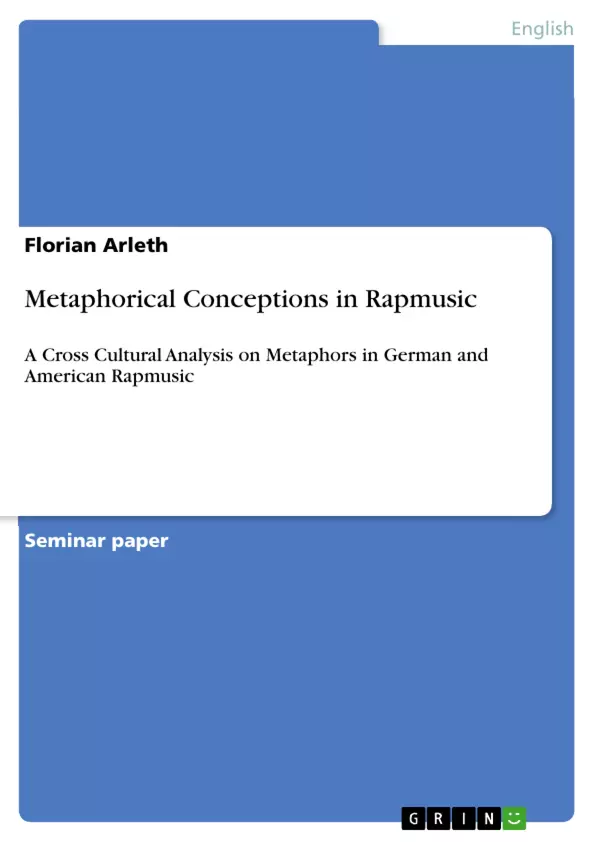In recent studies on cultural aspects of languages, subcultures have been given more and more
importance. On the metaphorical potential of such groups, Kövecses noted that
Subcultures develop their own metaphors, and these metaphors may define the group. There is of
course no subculture that defines itself through an entirely new set of metaphors, but some of the
metaphors members use may be new relative to the mainstream (Kövecses 2009: 286f).
And this might be especially true for the subculture of Hip Hop with its most important
manifestation being rap music. Despite the fact that the genre is in existence since the Seventies,
linguistic studies in this field are still rare, and investigations into the metaphorical inventory of rap
music literally not existent. A first and important step into that direction has been undertaken by
Scott Crossley, whose study shows the linguistic potential of rap music as well as its variety of
metaphors:
As a product of a historically oral culture that embodies familiar metaphorical traits [...], African
American rap music is especially rich in metaphoric language. Its roots, along with other African
American linguistic traditions (including signifying, the dozens, and narrativizing), give rap music its
exceptional linguistic variety (Crossley 2005: 503).
The present term paper will continue Crossley's research on metaphorical conceptions in rap music
by illustrating further conceptual metaphors, but it also likes to develop it into a new direction by
including German rap music as well. The relationship between American and German rap music is
especially interesting because it is coined by a linguistic impact that is by far not as strong on a
more general level. Certain aspects of this impact have already been laid down in earlier papers1,
and it will be most rewarding to explore its cognitive dimensions as well.
In the analysis three metaphorical concepts will be examined. They are illustrated with the
help of similar conceptions from everyday language and from an exemplary rap music corpus that is
more clearly defined in the next chapter. The methodical points of the analysis are laid down in this
chapter as well. And since the metaphorical conceptions in rap music “are generally specific to the
subculture that either adopts them from the dominant culture or creates them to address their own
cultural needs” (Crossley 2005: 501), variations on an intra cultural level will be noted as well.
Inhaltsverzeichnis (Table of Contents)
- Introduction
- A few Words on Method and Corpus
- Method
- Nature of the Corpus
- Rap Music as Battle
- Hip Hop as a Person
- Rap Artist as Craftsman
- Conclusion
- Intracultural Variation
- Intersubcultural Variation
- Individual Variation
Zielsetzung und Themenschwerpunkte (Objectives and Key Themes)
This term paper aims to investigate the metaphorical conceptions present in both American and German rap music, expanding upon previous research by Scott Crossley. The paper will analyze three conceptual metaphors, drawing examples from both everyday language and a diverse rap music corpus. Furthermore, it will explore the intracultural variations of these metaphors and investigate potential intersubcultural differences between the American and German rap music scenes.
- Conceptual metaphors in rap music
- Intracultural variation of metaphors
- Intersubcultural differences between American and German rap music
- The relationship between language and subculture
- The influence of social and cultural contexts on musical expression
Zusammenfassung der Kapitel (Chapter Summaries)
The introduction provides background information on the importance of subcultures in linguistic studies and highlights the scarcity of research on the metaphorical inventory of rap music. It discusses the linguistic potential of rap music and establishes the paper's objective to expand on Crossley's research by including German rap music.
Chapter 2 outlines the methodological approach and the nature of the corpus used in the analysis. It explains the use of Lakoff & Johnson's method for illustrating conceptual metaphors and emphasizes the importance of a diverse corpus that reflects the socio-cultural heterogeneity of the Hip Hop subculture.
Chapter 3 delves into the metaphorical concept of "Rap Music as Battle," drawing parallels between the linguistic expressions of rap music and the conceptual metaphor of "Arguments are war." It examines how rap music utilizes this metaphor to represent musical skills as weapons, verbal confrontations as battles, and lyrical superiority as victory. The chapter illustrates this concept with various examples from American and German rap music.
Schlüsselwörter (Keywords)
This term paper explores the metaphorical conceptions in rap music, focusing on the conceptual metaphor of "Rap Music as Battle." It examines the linguistic expressions of this metaphor in both American and German rap music, highlighting the intersubcultural variations and the influence of social and cultural contexts on musical expression. Key concepts include conceptual metaphors, linguistic diversity, subculture, rap music, and intercultural comparison.
- Quote paper
- Florian Arleth (Author), 2011, Metaphorical Conceptions in Rapmusic, Munich, GRIN Verlag, https://www.grin.com/document/190756



